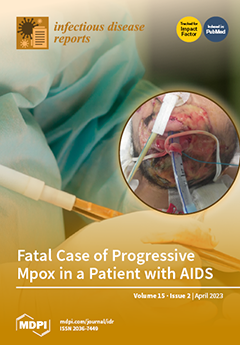The outcomes and characteristics of acute coronavirus disease 2019 (COVID-19) infection in patients with tuberculosis (TB) represent an evolving area of literature. This retrospective cohort study (March 2020–January 2021) within a large United States health system evaluated clinical and demographic characteristics, illness severity,
[...] Read more.
The outcomes and characteristics of acute coronavirus disease 2019 (COVID-19) infection in patients with tuberculosis (TB) represent an evolving area of literature. This retrospective cohort study (March 2020–January 2021) within a large United States health system evaluated clinical and demographic characteristics, illness severity, complications, and mortality associated with acute COVID-19 infection in patients with TB (n = 31) compared to a matched (1:3) COVID-19 cohort without TB (n = 93). In the COVID-19 + TB cohort, TB was active in 32% and latent in 65% of patients, most patients (55%) had pulmonary TB, and 68% had previously undergone treatment for their TB. Patients with COVID-19 + TB infection had higher rates of hospitalization (45% vs. 36%,
p = 0.34), intensive care unit (ICU) stay (16% vs. 8%,
p = 0.16), and need for mechanical ventilation (13% vs. 3%
p = 0.06). Discordant with those higher rates of markers typically denoting more severe illness, TB patients with acute COVID-19 did not have longer length-of-stay (5.0 vs. 6.1 days,
p = 0.97), in-hospital mortality (3.2% vs. 3.2%,
p = 1.00), or 30-day mortality (6.5% vs. 4.3%,
p = 0.63). This study, while having limitations for extrapolation, cautions the notion that patients with COVID-19 and TB infers worse outcomes and adds to the growing body of literature on the interaction between these two infections.
Full article






